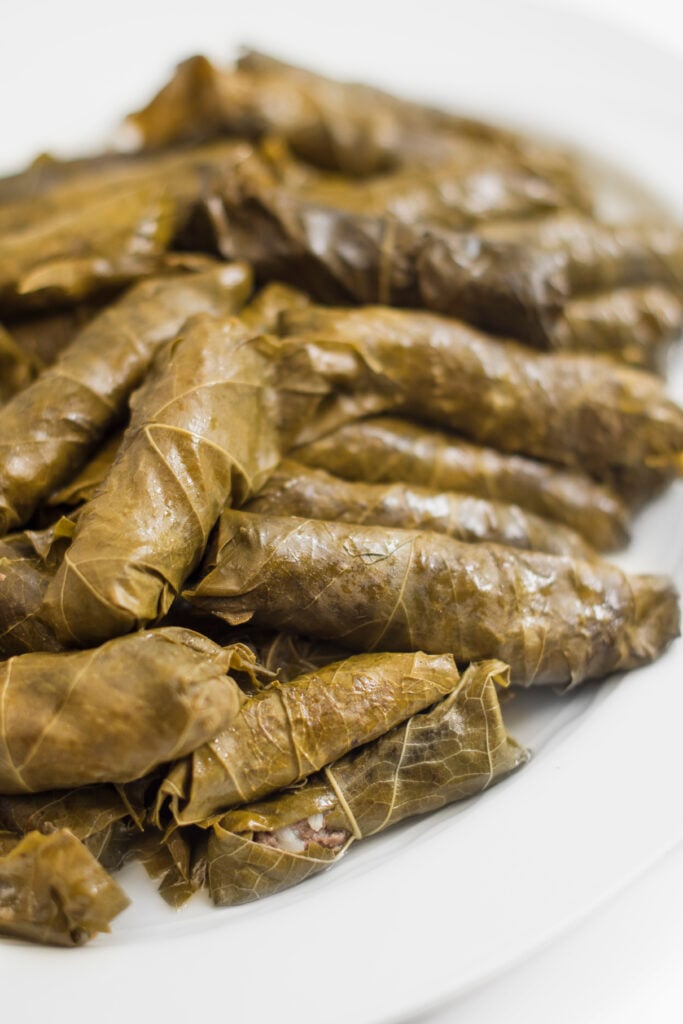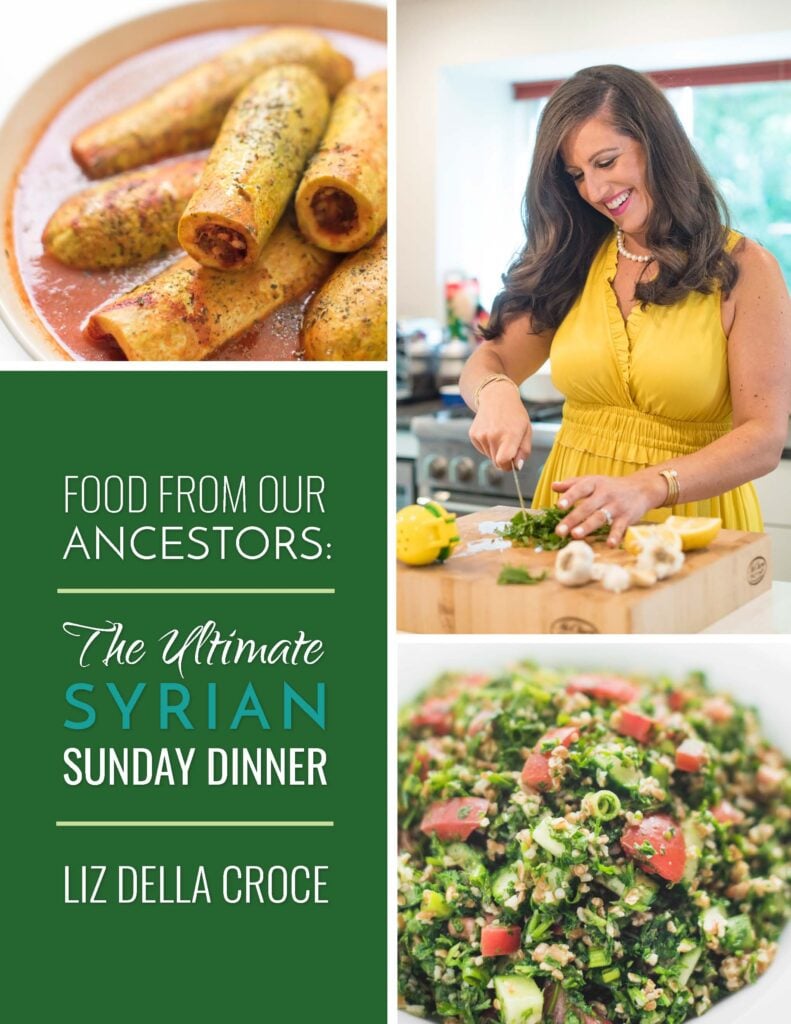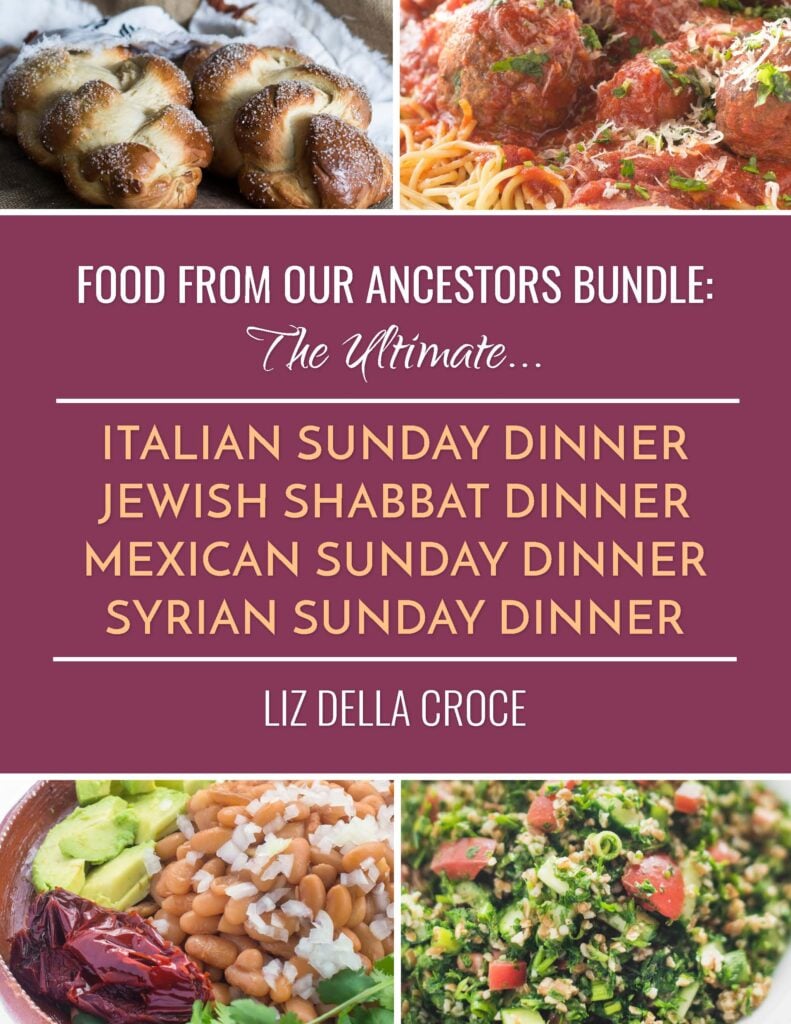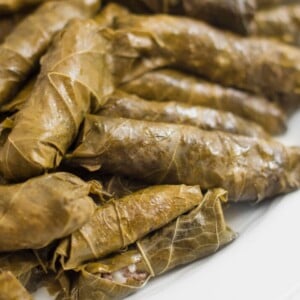Authentic Meat Stuffed Grape Leaves (Dolmas & Warak Enab): A Timeless Mediterranean Delicacy
There are certain dishes that transcend mere sustenance and become synonymous with tradition, comfort, and family. For many in the Middle East, and indeed across the Mediterranean, Meat Stuffed Grape Leaves – known as Warak Enab in Arabic or often referred to as Dolmas – hold this revered status. These tender parcels, filled with a savory mixture of ground meat and rice, are a beloved culinary masterpiece, enjoyed warm, cold, or at room temperature. My own mother, a true kitchen alchemist, always enriches the cooking pot with celery stalks and a few cabbage leaves, adding an extra layer of subtle flavor that permeates every single leaf.

I am absolutely thrilled to share this exquisite recipe for Meat Stuffed Grape Leaves with you today. Beyond just the recipe, I’m also excited to offer a glowing review of my dear friend Liz Della Croce’s newest eCookbook, Food From Our Ancestors: The Ultimate Syrian Sunday Dinner. Liz, the creative force behind The Lemon Bowl blog, has crafted a collection that resonates deeply with my own culinary heritage.
Exploring Shared Culinary Roots: Lebanese & Syrian Delights
Liz’s new eCookbook is a treasure trove of cherished recipes that instantly transport me back to my childhood. As many of you know, my family hails from Lebanon, and the culinary traditions of Lebanon and Syria are remarkably similar, almost like two sides of the same delicious coin. We grew up savoring the same vibrant flavors and wholesome dishes. From these very Meat Stuffed Grape Leaves to the refreshing Tabbouleh, the comforting Lubee: Lebanese Green Beans, and the hearty Baked Kibbeh, our childhood tables were laden with these Mediterranean and Middle Eastern staples. This shared heritage fuels our mutual passion for healthy eating and vibrant flavors.
My journey into the world of food blogging began five years ago, and Liz’s blog was one of the first I discovered. Her dedication to Mediterranean cuisine, coupled with her strong emphasis on healthy living, immediately captivated me. I found a kindred spirit in Liz, not just in our love for food but also in our shared experiences as mothers raising boys, and our connection to Michigan. Having spent time in that beautiful state myself, Michigan holds a special place in my heart, and I thoroughly enjoy following Liz’s life and culinary adventures from Grand Rapids.

Preserving our family recipes and gathering around a home-cooked meal on a Sunday evening is, to me, incredibly important. These moments of connection and conversation over delicious food are truly priceless. I’ve had the pleasure of preparing many of Liz’s recipes, and each one is not only bursting with authentic flavor but also crafted with healthy, nourishing ingredients. You can confidently serve her dishes to your family, knowing that every bite contributes to their well-being. Her commitment to wholesome, traditional cooking shines through in every page of her eCookbooks, making them an invaluable resource for anyone seeking both flavor and health.
The Ultimate Syrian Sunday Dinner & More
I wholeheartedly recommend purchasing her bundle of all four eCookbooks {links below} to immerse yourself in a world of authentic flavors. However, if you’re looking for a starting point, The Ultimate Syrian Sunday Dinners eCookbook is an absolute must-have. It puts a treasure trove of beloved Mediterranean recipes right at your fingertips, allowing you to recreate the magic of traditional Middle Eastern cooking in your own kitchen.
Are you curious about the specific culinary gems you’ll discover within this incredible eCookbook? Liz has curated a collection that truly celebrates the heart and soul of Syrian home cooking. Here are just a few of her remarkable family recipes you can find:
- Aunt Vieve’s Hummus with Toasted Pine Nuts: A creamy, rich hummus elevated with the nutty crunch of toasted pine nuts – a perfect appetizer.
- Cucumber Laban: A refreshing yogurt and cucumber dip, ideal for cooling the palate or accompanying heavier dishes.
- Tabbouleh Salad: The classic, vibrant herb and bulgur salad, bursting with fresh parsley and mint.
- Syrian Salad: A simple yet flavorful salad, often featuring crisp vegetables and a bright lemon dressing.
- Syrian Chicken Soup: A comforting and hearty soup, perfect for cold days or when you need a nourishing meal.
- Syrian Rice Pilaf: A fragrant and fluffy rice dish, often cooked with vermicelli for added texture.
- M/Juddarah: Lentils and Rice with Caramelized Onions: A humble yet incredibly satisfying vegetarian dish, known for its deep, earthy flavors.
- Stuffed Cabbage Rolls: Another form of beloved stuffed vegetables, offering a different texture and flavor profile than grape leaves.
- Bitten: Jen: Meat Stuffed Eggplant: A unique and delicious way to enjoy eggplant, filled with a savory meat mixture.
These recipes are more than just instructions; they are stories passed down through generations, embodying the warmth and generosity of Syrian hospitality.

Mastering Meat Stuffed Grape Leaves: Tips for Success
Making Warak Enab is a labor of love, but the results are incredibly rewarding. Here are some key tips to ensure your meat-stuffed grape leaves turn out perfectly every time:
- Choosing Your Grape Leaves: You can find brined grape leaves in jars at most Middle Eastern or international grocery stores. If using fresh leaves, blanch them quickly in boiling water to make them pliable. Jarred leaves should be rinsed thoroughly to remove excess salt.
- The Filling is Key: The combination of ground sirloin (or a mix of beef and lamb for richer flavor), well-rinsed long-grain rice, fresh garlic, and vibrant lemon juice is essential. Don’t skimp on the salt and pepper; proper seasoning elevates the entire dish. The addition of dried mint is a signature flavor in many Lebanese and Syrian recipes, providing an aromatic freshness.
- Rinsing the Rice: Rinsing the rice is crucial to remove excess starch, preventing the filling from becoming too sticky and ensuring each grain cooks up perfectly fluffy inside the leaf.
- Rolling Technique: While the instructions suggest forming a “thin cigar shape” and rolling from the stem, practice makes perfect. Don’t worry if your first few aren’t perfect; they’ll still taste amazing! The key is a firm but not overly tight roll to allow the rice to expand. Folding in the sides creates a neater, more secure package.
- Layering in the Pot: Lining the pot with celery and cabbage leaves not only infuses more flavor but also prevents the bottom layer of grape leaves from scorching. Layering the stuffed leaves snugly, alternating directions with each layer, helps them cook evenly and prevents them from unraveling during simmering.
- Cooking Liquid: Ensure there’s enough liquid (water and lemon juice) to completely cover the grape leaves by at least an inch. The upside-down plate technique is genius – it keeps the delicate rolls submerged and prevents them from floating and coming apart.
- Patience in Simmering: Low and slow is the way to go. The extended simmer ensures the meat is cooked through, the rice is tender, and the grape leaves are soft and infused with all the wonderful flavors.
These Warak Enab are more than just a dish; they’re an experience. They embody the heart of Mediterranean cuisine: fresh ingredients, traditional techniques, and the joy of sharing. Whether you’re making them for a special occasion or a simple Sunday dinner, they are sure to be a showstopper and a cherished part of your culinary repertoire.
More Lebanese & Mediterranean Recipes to Explore
If you’ve enjoyed the taste of these delectable Meat Stuffed Grape Leaves, you’re likely to fall in love with other traditional Lebanese and Mediterranean dishes. Our cuisine is rich in flavor, fresh ingredients, and heartwarming meals that are perfect for any occasion. Explore these additional recipes to further expand your culinary horizons and bring the authentic tastes of the Middle East to your kitchen.
Vegetarian
Easy Stuffed Grape Leaves (Vegetarian)
Beef
Lebanese Meat Pie Recipe (Sfeeha)
Mediterranean
Easy Spinach Fatayer Recipe (Lebanese Spinach Pies)
Vegetarian
Fattoush Salad
Tried this recipe? Leave a star rating and comment below! Subscribe to my newsletter or follow me on
Facebook,
Instagram, or
Pinterest for the latest.
Meat Stuffed Grape Leaves (Warak Enab)

Saved
Pin
Ingredients
- one 2-pound jar of grape leaves, roughly 50 leaves, rinsed well
- 1 pound ground sirloin (or lean ground beef/lamb mix)
- 1/2 cup long-grain white rice, rinsed thoroughly
- 1 tablespoon minced garlic
- 1 1/2 teaspoons salt (adjust to taste)
- 1 teaspoon black pepper
- Juice of two lemons (about 1/2 cup total)
- 2 celery stalks, cut into thirds (optional, for layering)
- 5 cabbage leaves, optional (for layering)
- 2 tablespoons dried mint
Instructions
-
Prepare the Pot: Line a large heavy-bottomed pot with the cut celery ribs and loose cabbage leaves. This layer helps prevent the grape leaves from sticking and adds subtle flavor.
-
Prepare the Grape Leaves: Place rinsed grape leaves on a plate. Gently trim any large, thick stems from the bottom of each leaf. Ensure they are fully unrolled and ready for stuffing.
-
Make the Filling: In a large mixing bowl, combine the ground meat, thoroughly rinsed rice, juice of one lemon, minced garlic, salt, and pepper. Mix well by hand until all ingredients are evenly distributed.
-
Stuff & Roll: Working one grape leaf at a time, lay the leaf flat on a clean surface or plate, shiny side down (veiny side up). Place about 1 tablespoon of the meat mixture near the stem end of the leaf.
-
Form the Rolls: Form the meat mixture into a thin cigar shape. Fold the bottom edge of the grape leaf over the filling, then fold in the sides, and tightly roll the leaf all the way to the top. This creates a neat, compact roll.
-
Layer in the Pot: Carefully arrange the stuffed grape leaves in the prepared pot, packing them snugly. Alternate the direction of the rolls with each layer to create a stable structure. Continue until the pot is about 3/4 full or you’ve used all your leaves.
-
Add Liquid & Flavor: Cover the grape leaves with water, ensuring there’s at least one inch of liquid above the top layer. Pour in the remaining lemon juice and sprinkle generously with dried mint.
-
Weigh Down & Cook: Place a small, heat-proof plate upside down directly on top of the grape leaves. This helps keep them submerged and prevents them from unraveling during cooking. Cover the pot with its lid.
-
Simmer to Perfection: Bring the pot to a gentle simmer over medium-high heat. Once simmering, reduce the heat to low and continue to simmer for 15 minutes, or until the rice inside the leaves is fully cooked and tender.
-
Serve: Carefully remove the plate and serve your delicious Meat Stuffed Grape Leaves warm, accompanied by fresh pita bread and a side of cooling cucumber laban (yogurt sauce). They are also excellent chilled the next day!
Nutrition
Nutrition information is automatically calculated, so should only be used as an approximation.
Recipe adapted from Liz Della Croce from The Lemon Bowl & her eCookbook.
Frequently Asked Questions About Stuffed Grape Leaves
What are Meat Stuffed Grape Leaves?
Meat Stuffed Grape Leaves, often called Warak Enab (Arabic) or Dolmas (Turkish/Greek), are a traditional Middle Eastern and Mediterranean dish consisting of brined grape leaves wrapped around a savory filling. The filling typically includes ground meat (beef, lamb, or a mix), rice, fresh herbs (like parsley and mint), garlic, and a touch of lemon juice and spices. They are then simmered in a flavorful broth until tender.
Can I make Warak Enab vegetarian?
Absolutely! Vegetarian versions of stuffed grape leaves are very popular. Instead of meat, the filling often includes more rice, chickpeas, chopped vegetables (like tomatoes, onions, parsley, mint), and a generous amount of olive oil and lemon juice. Many cultures have delicious meat-free variations of Dolmas.
What kind of grape leaves should I use?
The most common and easiest to find are brined grape leaves sold in jars or cans at international or Middle Eastern grocery stores. If you have access to fresh grape leaves, blanch them quickly in boiling water to soften them before use. Always rinse brined leaves thoroughly to remove excess salt.
How long do Stuffed Grape Leaves last?
Cooked Meat Stuffed Grape Leaves can be stored in an airtight container in the refrigerator for 3-4 days. They are often considered even more flavorful the next day after the flavors have had time to meld. They can also be frozen for up to 2-3 months; thaw overnight in the refrigerator and gently reheat.
What do I serve with Meat Stuffed Grape Leaves?
Traditionally, Warak Enab are served with fresh pita bread and a cooling yogurt sauce, such as cucumber laban or plain yogurt. They can also be part of a larger mezze platter with other Middle Eastern appetizers like hummus, tabbouleh, and various salads. For a complete meal, they pair wonderfully with additional lemon wedges for extra brightness.
Why do my grape leaves unroll during cooking?
Grape leaves can unroll if they are not rolled tightly enough, or if they are packed too loosely in the pot. Using an upside-down plate on top of the rolls during simmering helps to weigh them down and keeps them from floating and coming apart, ensuring they maintain their shape throughout the cooking process.
